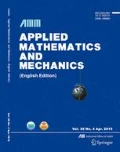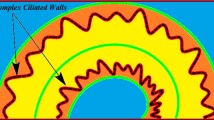Abstract
This paper presents a theoretical study of a non-linear rheological fluid transport in an axisymmetric tube by cilia. An attempt has been made to explain the role of cilia motion in the transport of fluid through the ductus efferent of the male reproductive tract. The Ostwald-de Waele power-law viscous fluid is considered to represent the rheological fluid. We analyze pumping by means of a sequence of cilia beats from row-to-row of cilia in a given row of cells and from one row of cells to the next (metachronal wave movement). For this purpose, we consider the conditions that the corresponding Reynolds number is small enough for inertial effects to be negligible, and the wavelength-to-diameter ratio is large enough so that the pressure can be considered uniform over the cross section. Analyses and computations of the fluid motion reveal that the time-average flow rate depends on ϵ, a non-dimensional measure involving the mean radius a of the tube and the cilia length. Thus, the flow rate significantly varies with the cilia length. Moreover, the flow rate has been reported to be close to the estimated value 6×10−3 ml/h for human efferent ducts if ϵ is near 0.4. The estimated value was suggested by Lardner and Shack (Lardner, T. J. and Shack, W. J. Cilia transport. Bulletin of Mathematical Biology, 34, 325–335 (1972)) for human based on the experimental observations of flow rates in efferent ducts of other animals, e.g., rat, ram, and bull. In addition, the nature of the rheological fluid, i.e., the value of the fluid index n strongly influences various flow-governed characteristics. An interesting feature of this paper is that the pumping improves the thickening behavior for small values of ϵ or in free pumping (ΔP = 0) and pumping (ΔP > 0) regions.
Similar content being viewed by others
References
Lardner, T. J. and Shack, W. J. Cilia transport. Bulletin of Mathematical Biology, 34, 325–335 (1972)
Hess, R. A. Small tubules, surprising discoveries: from efferent ductules in the turkey to the discovery that estrogen receptor alpha is essential for fertility in the male. Animal Reproduction, 12, 7–23 (2015)
Ilio, K. Y. and Hess, R. A. Structure and function of the ductuli efferentes: a review. Microscopy Research and Technique, 29, 432–467 (1994)
Rivera, J. A. Cilia, Ciliated Epithelium, and Ciliary Activity, Pergamon Press, New York (1962)
Sleigh, M. A. The Biology of Cilia and Flagella, MacMillan, New York (1962)
Sleigh, M. A. Patterns of Ciliary Beating, Academic Press, New York (1968)
Lucus, A. M. Ciliated epithelium. Special Cytology, 1, 409–473 (1932)
Setchell, B. P. Testicular Blood Supply, Lymphatic Drainage, and Secretion of Fluid, Academic Press, New York (1970)
Winet, H. On the mechanism for flow in the efferent ducts. Journal of Andrology, 1, 304–311 (1980)
Benoit, M. J. Recherches anatomiques, cytologiques et histophysiologiques sur les voies excrétrices du testicule, chez les mammifères. Archives D’anatomie, D’histologie et D’embryologie Normales et Experimentales, 5, 173–412 (1926)
Aire, T. A. and Josling, D. Ultrastructural study of the luminal surface of the ducts of the epi- didymis of gallinaceous birds. Onderstepoort Journal of Veterinary Research, 67, 191–199 (2000)
Borell, U., Milsson, O., and Westman, A. Ciliary activity in the rabbit fallopian tube during oestrus and after copulation. Acta Obstetricia et Gynecologica Scandinavica, 36, 22–28 (1957)
Jahn, T. L. and Bovee, E. C. Movement and locomotion of microorganism. Annual Review of Microbiology, 19, 21–58 (1965)
Jahn, T. L. and Bovee, E. C. Motile behaviour of protozoa. Research in Protozoology, 1, 41–110 (1967)
Blake, J. R. A model for the microstructure in ciliated micro-organisms. Journal of Fluid Mechanics, 55, 1–23 (1972)
Blake, J. R. A spherical envelope approach to ciliary propulsion. Journal of Fluid Mechanics, 46, 199–208 (1971)
Miller, C. E. The kinematics and dynamics of ciliary fluid systems. Journal of Experimental Biology, 49, 617–629 (1968)
Miller, C. E. An investigation of the movement of Newtonian liquids initiated and sustained by the oscillation of mechanical cilia. Aspen Emphysema Conference, 10, 309–321 (1967)
Miller, C. E. Streamlines, steak lines and particle pathlines associate with a mechanically-induced flow holomorphic with the mammalian mucociliary system. Biorheology, 6, 127–135 (1969)
Barton, C. and Raynor, S. Analytical investigation of cilia induced mucous flow. The Bulletin of Mathematical Biophysics, 29, 419–428 (1967)
Weiss, L. and Greep, R. O. Histology, McGraw-Hill, New York (1983)
Blandau, R. J. Gamete Transport-Comparative Aspects, University of Chicago Press, Chicago (1969)
Sturgis, S. H. The effect of ciliary current on sperm progress in excised human fallopian tubes. Transactions of the American Society for the Study of Sterility, 3, 31–39 (1947)
Tuck, R. R., Setchel B. P., Waites, G. M. H., and Young, J. A. The composition of fluid collected by micropuncture and catherization from the seminiferous tubules and rete testis of rats. Pflügers Archiv, 318, 225–243 (1970)
Waites, G. M. H. and Setchell, P. P. Some Physiological Aspects of the Function of the Testis, North-Holland Publishing Company, New York (1969)
Malek, J., Necas, J., and Rajagopal, K. R. Global existence of solutions for fluids with pressure and shear dependent viscosities. Applied Mathematics Letters, 15, 961–967 (2002)
Dunn, P. F. and Picologlou, B. F. Investigation of rheological properties of human semen. Biorheology, 14, 277–292 (1977)
Mendeluk, G., Flecha, F. L. G., Castello, P. R., and Bregni, C. Factors involved in the biochemical etiology of human seminal plasma hyperviscosity. Journal of Andrology, 21, 262–267 (2000)
Xue, H. The modified Casson’s equation and its application to pipe flows of shear thickening fluid. Acta Mechanica Sinica, 21, 243–248 (2005)
Misra, J. C. and Maiti, S. Peristaltic transport of rheological fluid: model for movement of food bolus through esophagus. Applied Mathematics and Mechanics (English Edition), 33, 15–32 (2012) DOI 10.1007/s10483-012-1552-7
Misra, J. C. and Maiti, S. Peristaltic pumping of blood through small vessels of varying cross- section. Journal of Applied Mechanics-Transactions of the ASME, 22, 061003 (2012)
Misra, J. C. and Pandey, S. K. Peristaltic flow of a multi-layered power-law fluid through a cylindrical tube. International Journal of Engineering Science, 39, 387–402 (2001)
Maiti, S. and Misra, J. C. Peristaltic transport of a couple stress fluid: some applications to hemodynamics. Journal of Mechanics in Medicine and Biology, 12, 1250048 (2012)
Liu, Y. and Boling, G. Coupling model for unsteady MHD flow of generalized Maxwell fluid with radiation thermal transform. Applied Mathematics and Mechanics (English Edition), 37, 137–150 (2016) DOI 10.1007/s10483-016-2021-8
Hayat, T., Asad, S., and Alsaedi, A. Flow of Casson fluid with nanoparticles. Applied Mathematics and Mechanics (English Edition), 37, 459–470 (2016) DOI 10.1007/s10483-016-2047-9
Siddiqui, A. M., Ashraf, H., Walait, A., and Haroon, T. On study of horizontal thin film flow of Sisko fluid due to surface tension gradient. Applied Mathematics and Mechanics (English Edition), 36, 847–862 (2015) DOI 10.1007/s10483-015-1952-9
Ding, Z., Jian, Y., and Yang, L. Time periodic electroosmotic flow of micropolar fluids through microparallel channel. Applied Mathematics and Mechanics (English Edition), 36, 769–786 (2016) DOI 10.1007/s10483-016-2081-6
Srivastava, L. M. and Srivastava, V. P. Peristaltic transport of a power-law fluid: application to the ductus efferentes of the reproductive tract. Rheologica Acta, 27, 428–433 (1988)
Usha, S. and Rao, A. R. Peristaltic transport of two-layered power-law fluids. Journal of Biomechanical Engineering, 119, 483–488 (1997)
Rao, A. R. and Mishra, M., Peristaltic transport of a power-law fluid in a porous tube. Journal of Non-Newtonian Fluid Mechanics, 121, 163–174 (2004)
Childress, S. Mechanics of Swimming and Flying, Cambridge University Press, Cambridge (1981)
Lauga, E. and Powers, T. R. The hydrodynamics of swimming microorganisms. Reports on Progress in Physics, 72, 096601 (2009)
Blake, J. R. Flow in tubules due to ciliary activity. Bulletin of Mathematical Biology, 35, 513–523 (1973)
Vlez-Cordero, J. R. and Lauga, E. Waving transport and propulsion in a generalized Newtonian fluid. Journal of Non-Newtonian Fluid Mechanics, 199, 37–50 (2013)
Brennen, C. An oscillating-boundary-layer theory for ciliary propulsion. Journal of Fluid Mechanics, 65, 799–824 (1974)
Lauga, E. Propulsion in a viscoelastic fluid. Physics of Fluids, 19, 083104 (2007)
Lauga, E. Life at high Deborah number. Europhysics Letters, 86, 64001 (2009)
Siddiqui, A. M., Haroon, T., Rani, R., and Ansari, A. R. An analysis of the flow of a power law fluid due to ciliary motion in an infinite channel. Journal of Biorheology, 24, 56–69 (2010)
Agarwal, H. and Anawaruddin. Cilia transport of bio-fluid with variable viscosity. Indian Journal of Pure and Applied Mathematics, 15, 1128–1139 (1984)
Blake, J. R. On the movement of mucus in the lungs. Journal of Biomechanics, 8, 179–190 (1975)
Satir, P. Studies on cilia: the fixation of the metachronal wave. The Journal of Cell Biology, 18, 345–365 (1963)
Maiti, S. and Misra, J. C. Non-Newtonian characteristics of peristaltic flow of blood in micro- vessels. Communications in Nonlinear Science and Numerical Simulation, 18, 1970–1988 (2013)
Shapiro, A. H., Jaffrin, M. Y., and Weinberg, S. L. Peristaltic pumping with long wavelength at low Reynolds number. Journal of Fluid Mechanics, 37, 799–825 (1969)
Moulik, S., Gopalkrishnan, K., Hinduja, I., and Shahani, S. K. Presence of sperm antibodies and association with viscosity of semen. Human Reproduction, 4, 290–291 (1989)
Fawcett, D. Cilia and Flagella, Academic Press, New York (1961)
Bird, R. B., Stewart, W. E., and Lightfoot, E. N. Transport Phenomena, John Wiley and Sons, Singapore (1960)
Takabatake, S. and Ayukawa, K. Numerical study of two-dimensional peristaltic flows. Journal of Fluid Mechanics, 122, 439–465 (1982)
Acknowledgements
One of the authors, S. MAITI, is grateful to the University Grants Commission (UGC), New Delhi for awarding Dr.D. S. Kothari Post Doctoral Fellowship during this investigation.
Author information
Authors and Affiliations
Corresponding author
Rights and permissions
About this article
Cite this article
Maiti, S., Pandey, S.K. Rheological fluid motion in tube by metachronal waves of cilia. Appl. Math. Mech.-Engl. Ed. 38, 393–410 (2017). https://doi.org/10.1007/s10483-017-2179-8
Received:
Revised:
Published:
Issue Date:
DOI: https://doi.org/10.1007/s10483-017-2179-8
Key words
- non-Newtonian fluid
- cilia movement
- metachronal wave
- volumetric flow
- flow reversal
- velocity at wave crest and trough



